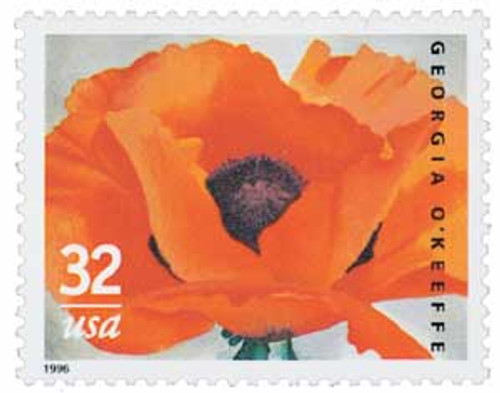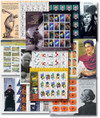
1996-2002 Small Panes, collection of 9 sheets
# 3069//3652 - 1996-2002 Small Panes, collection of 9 sheets
$275.00
3069//3652
1996-2002 Small Pane Collection
These 9 small panes commemorate artists, sports, and science:
Georgia O’Keefe – One of America’s leading artists, Georgia O’Keeffe is known for her sensitive, semi-abstract paintings derived from nature. Linked with the first generation of American modernists, her impressive career spanned the entire history of modern art. While much of the modernist work showed a strong European influence, O’Keeffe developed her own unique style, reducing and simplifying forms to an abstract study of color and light. Her best-known subjects included flowers, animal bones, and rocks.
O’Keeffe was strongly impressed by the beauty of the desert during a visit to New Mexico in 1929. Greatly influencing her work, the Southwest landscape became one of her favorite subjects. During the 1950s she began to travel extensively, and in 1959 even made a trip around the world. From that journey and subsequent airplane flights came her series on the sky and clouds.
Centennial Olympic Games – Appropriately, the Olympic Games centennial stamp pictures the “Discus Thrower” – the king of athletes among ancient Greeks – whose purposeful action is captured in Myron’s 5th-century B.C. statue Discobolus.
Believing sports would promote world peace, Pierre de Coubertin, a French advocate of physical education, championed the formation of modern Olympic games. The first were held in Athens in 1896 where 285 athletes, representing 13 nations, competed in 42 events. In 1996, 11,000 athletes from 197 nations competed in hundreds of events at the Summer Olympics in Atlanta.
Alexander Calder – Alexander Calder is considered one of the most well-known artists of the twentieth century. Primarily a sculptor, Calder created several different abstract works of art. He is most famous for his sculptures known as mobiles. Mobiles are balanced arrangements that move using wind currents. One such work, "Black Cascade, 13 Verticals," is pictured on one of these stamps.
American Glass – These stamps feature four styles of American glass: free-blown, mold-blown, pressed, and art glass.
The first successful American glassmaker was Caspar Wistar. His plant in New Jersey operated from 1739 to 1780. A second important name in American glassmaking is Henry William Stiegel. Both Wistar and Stiegel were founders of distinctive American glass styles.
Few glass manufacturers survived the Revolutionary War. One that did was the New Bremen (Maryland) Glass Manufactory, which made bowls, bottles, and goblets that are engraved with mottoes, monograms, crests, and wreaths.
Perhaps the most famous art-style glass items crafted in the U.S. today are created at the Steuben Glass Company in Corning, New York. Established in 1903 by Englishman Frederick Carder, most Steuben pieces are entirely handmade, and either completely unadorned or copper-wheel engraved. Steuben products have become classics of 20th century glassmaking.
Louise Nevelson –one of America’s most inventive, yet unrecognized, sculptors. Born in Russia, Nevelson (1899-1988) and her family began a new life in Maine in 1905. She later married and moved to New York City, where she lived and worked most of her life.
Determined to get noticed, Nevelson exhibited her work at every gallery that asked in the 1940s and ‘50s. Her strategy paid off in 1955, when she began a series of shows at the Grand Central Moderns in Manhattan.
Nevelson’s contemporary sculptures were influenced by her childhood in Maine and her experiences in New York City. She prowled the streets of Manhattan in search of discarded packing materials, boxes, crates, and scraps of wood and metal to transform into her own distinct works of art. Chair legs, broom handles, and cabinet doors often found their way into her pieces. Expansive, three-dimensional walls of wood painted black, white, or gold are trademarks of Nevelson’s style of artwork. But she also created sculptures from terra-cotta, plaster, steel, and plexiglass.
Many of Nevelson’s contemporary sculptures are on display in New York City. In 1972, she presented the city with “Night Presence IV” for Christmas. It remains in place at Park Avenue and 92nd Street.
Edwin Powell Hubble Telescope images –The images used on these stamps were taken by the Hubble Space Telescope, launched into space on April 25, 1990. The huge instrument can see the cosmos clearer than land-based telescopes because of its position above Earth's distorting atmosphere. It was named for Edwin Powell Hubble, an American astronomer whose studies helped explain the universe.
Frida Kahlo –widely regarded as one of the most important twentieth-century female artists in the Americas. Kahlo rejected European-based art and culture in favor of Mexican folk art and the foundations of ancient Mexico. Many of her paintings are self-portraits, such as the one on this stamp.
Baseball’s Legendary Playing Fields – Vintage postcards of ten famous baseball fields are displayed on this se-tenant. Descriptive text appears on the back of each stamp.
Featured stadiums include: Ebbets Field (Brooklyn), Tiger Stadium (Detroit), Crosley Field (Cincinnati), Yankee Stadium (New York City), Polo Grounds (New York City), Forbes Field (Pittsburgh), Fenway Park (Boston), Comiskey Park (Chicago), Shibe Park (Philadelphia), Wrigley Field (Chicago).
Andy Warhol –a leader of the 1960s’ Pop Art movement. Pop artists focused on familiar commercial images that had become part of the popular culture. Warhol became famous in 1962 with silkscreen prints of Marilyn Monroe, dollar notes, and Campbell’s Soup Cans.
3069//3652
1996-2002 Small Pane Collection
These 9 small panes commemorate artists, sports, and science:
Georgia O’Keefe – One of America’s leading artists, Georgia O’Keeffe is known for her sensitive, semi-abstract paintings derived from nature. Linked with the first generation of American modernists, her impressive career spanned the entire history of modern art. While much of the modernist work showed a strong European influence, O’Keeffe developed her own unique style, reducing and simplifying forms to an abstract study of color and light. Her best-known subjects included flowers, animal bones, and rocks.
O’Keeffe was strongly impressed by the beauty of the desert during a visit to New Mexico in 1929. Greatly influencing her work, the Southwest landscape became one of her favorite subjects. During the 1950s she began to travel extensively, and in 1959 even made a trip around the world. From that journey and subsequent airplane flights came her series on the sky and clouds.
Centennial Olympic Games – Appropriately, the Olympic Games centennial stamp pictures the “Discus Thrower” – the king of athletes among ancient Greeks – whose purposeful action is captured in Myron’s 5th-century B.C. statue Discobolus.
Believing sports would promote world peace, Pierre de Coubertin, a French advocate of physical education, championed the formation of modern Olympic games. The first were held in Athens in 1896 where 285 athletes, representing 13 nations, competed in 42 events. In 1996, 11,000 athletes from 197 nations competed in hundreds of events at the Summer Olympics in Atlanta.
Alexander Calder – Alexander Calder is considered one of the most well-known artists of the twentieth century. Primarily a sculptor, Calder created several different abstract works of art. He is most famous for his sculptures known as mobiles. Mobiles are balanced arrangements that move using wind currents. One such work, "Black Cascade, 13 Verticals," is pictured on one of these stamps.
American Glass – These stamps feature four styles of American glass: free-blown, mold-blown, pressed, and art glass.
The first successful American glassmaker was Caspar Wistar. His plant in New Jersey operated from 1739 to 1780. A second important name in American glassmaking is Henry William Stiegel. Both Wistar and Stiegel were founders of distinctive American glass styles.
Few glass manufacturers survived the Revolutionary War. One that did was the New Bremen (Maryland) Glass Manufactory, which made bowls, bottles, and goblets that are engraved with mottoes, monograms, crests, and wreaths.
Perhaps the most famous art-style glass items crafted in the U.S. today are created at the Steuben Glass Company in Corning, New York. Established in 1903 by Englishman Frederick Carder, most Steuben pieces are entirely handmade, and either completely unadorned or copper-wheel engraved. Steuben products have become classics of 20th century glassmaking.
Louise Nevelson –one of America’s most inventive, yet unrecognized, sculptors. Born in Russia, Nevelson (1899-1988) and her family began a new life in Maine in 1905. She later married and moved to New York City, where she lived and worked most of her life.
Determined to get noticed, Nevelson exhibited her work at every gallery that asked in the 1940s and ‘50s. Her strategy paid off in 1955, when she began a series of shows at the Grand Central Moderns in Manhattan.
Nevelson’s contemporary sculptures were influenced by her childhood in Maine and her experiences in New York City. She prowled the streets of Manhattan in search of discarded packing materials, boxes, crates, and scraps of wood and metal to transform into her own distinct works of art. Chair legs, broom handles, and cabinet doors often found their way into her pieces. Expansive, three-dimensional walls of wood painted black, white, or gold are trademarks of Nevelson’s style of artwork. But she also created sculptures from terra-cotta, plaster, steel, and plexiglass.
Many of Nevelson’s contemporary sculptures are on display in New York City. In 1972, she presented the city with “Night Presence IV” for Christmas. It remains in place at Park Avenue and 92nd Street.
Edwin Powell Hubble Telescope images –The images used on these stamps were taken by the Hubble Space Telescope, launched into space on April 25, 1990. The huge instrument can see the cosmos clearer than land-based telescopes because of its position above Earth's distorting atmosphere. It was named for Edwin Powell Hubble, an American astronomer whose studies helped explain the universe.
Frida Kahlo –widely regarded as one of the most important twentieth-century female artists in the Americas. Kahlo rejected European-based art and culture in favor of Mexican folk art and the foundations of ancient Mexico. Many of her paintings are self-portraits, such as the one on this stamp.
Baseball’s Legendary Playing Fields – Vintage postcards of ten famous baseball fields are displayed on this se-tenant. Descriptive text appears on the back of each stamp.
Featured stadiums include: Ebbets Field (Brooklyn), Tiger Stadium (Detroit), Crosley Field (Cincinnati), Yankee Stadium (New York City), Polo Grounds (New York City), Forbes Field (Pittsburgh), Fenway Park (Boston), Comiskey Park (Chicago), Shibe Park (Philadelphia), Wrigley Field (Chicago).
Andy Warhol –a leader of the 1960s’ Pop Art movement. Pop artists focused on familiar commercial images that had become part of the popular culture. Warhol became famous in 1962 with silkscreen prints of Marilyn Monroe, dollar notes, and Campbell’s Soup Cans.











